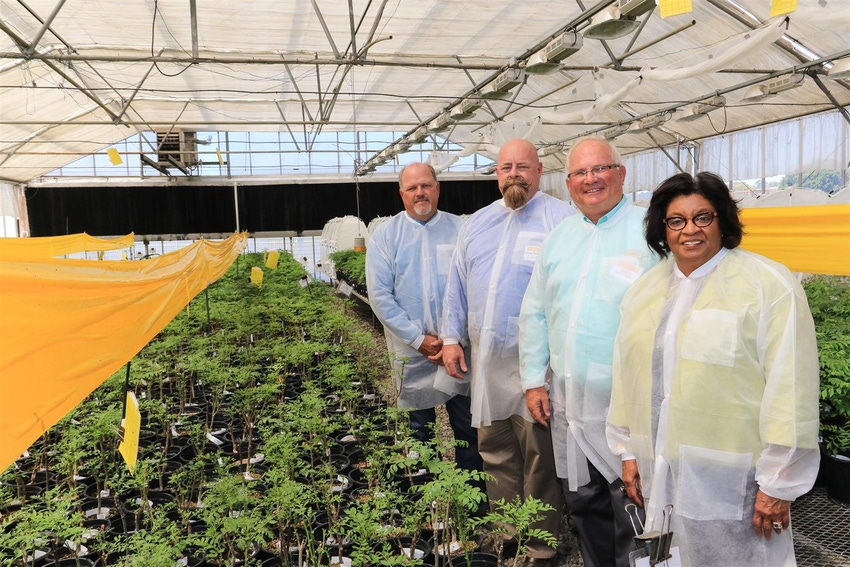
California citrus leaders are pinning success in their fight against the disease Huanglongbing (HLB) on expanded public-private partnerships.
Since discovering the incurable citrus disease, also known as citrus greening, in a Los Angeles suburb in 2012, California’s multi-billion dollar citrus industry has been trying to quickly learn as much as possible about what leaders call “an insidious disease.”
“Huanglongbing is the biggest threat the California citrus industry has ever faced,” said Nick Hill, chairman of the CPDPP and a San Joaquin Valley citrus grower.
More recently, the industry forged partnerships with public and private entities with the ultimate goal of finding a cure for the disease.
At Cal Poly Pomona recently, representatives of the citrus industry cut the ribbon on a new 5,000 square-foot research greenhouse facility that will aid in research and breeding biological control methods to address endemic populations of the Asian citrus psyllid (ACP) in urban areas of the state.
The greenhouse facility was built through a collaborative effort with the Citrus Research Board, with construction funded through a $400,000 grant from the California Citrus Pest and Disease Prevention Program (CPDPP). The program is funded by California’s commercial citrus growers.
The new facility on the Cal Poly Pomona campus will support research and rearing of the Tamarixia radiata wasp, a natural enemy of the ACP. The wasp was discovered by University of California researchers several years ago in Pakistan who brought it back to the United States with a permit from the U.S. Department of Agriculture.
Production of Tamarixia already occurs at a state facility in nearby Riverside, Calif., but those numbers – about two million insects per year – are not enough as the psyllid continues to expand its footprint across California.
Psyllids have been found as far north as the Bay Area and the northern San Joaquin Valley.
Tamarixia radiata
The Tamarixia radiata is a tiny parasitic wasp that lays its eggs inside developing ACP nymphs. Researchers have reported seeing adult wasps attack adult ACP. Research in southern California has shown parasitism rates of 20-88 percent, depending on the geographical location and the time of year.
Since the Tamarixia was first introduced into California, a second parasitic wasp - Diaphorencyrtus aligarhensis - was also found in Pakistan and subjected to similar regulatory investigation and subsequent introduction in the ACP battle. It has been released into urban settings as a biological control against the ACP.
Both wasps are much smaller than the gnat-sized ACP, but are effective at controlling ACP populations.
Using Tamarixia radiata and Diaphorencyrtus aligarhensis as integrated pest management (IPM) tools against the psyllid is one method university researchers believe may slow the spread of HLB. Because neither insect can be employed with organic or conventional chemical control methods used against the ACP, biological controls are the only recommended way to address ACP populations in urban settings where chemical controls are not used.
While curing the citrus disease itself remains the ultimate target of an industry trying to avoid certain death, the ACP remains the main vehicle to transmit HLB to citrus trees. Because of this, pest control will continue as a high priority as the industry searches for a cure to the disease.
Even the use of the organically-approved insecticide combination of Spinosad plus oil against the ACP has been found to be highly toxic to the Tamarixia, according to an article published by UC Riverside Entomologists Nastaran Tofangsazi and Beth Grafton-Cardwell.
“Biological control is not a silver bullet,” Hill says. “But it helps lower populations of the Asian citrus psyllid, thus limiting the opportunities for Huanglongbing to spread.”
Partnerships
California Citrus Mutual (CCM) President Joel Nelsen says the partnership his organization has with Cal Poly Pomona is part of a larger effort the citrus industry has with UC Riverside, the University of California, the California Department of Food and Agriculture (CDFA), Cooperative Extension Master Gardeners, and the U.S. Department of Agriculture to try to beat back HLB.
Bayer CropScience also has partnered with CCM to help fund a tree removal program. Other private companies are said to be nearing partnership agreements with CCM.
Nelsen says the partnerships and the individual efforts of each participant are crucial in the industry’s fight against HLB. In short, the California citrus industry is in a fight for its very life as citrus production in Florida continues to decline as that state wrestles with an HLB infection rate of nearly 100 percent.
A recent article in Southeast Farm Press reported that Florida’s juice-based citrus industry may no longer be commercially viable after 2019.
“That’s why this effort needs to be multi-faceted,” Nelsen said. “It’s the only way to run a successful campaign and not go the direction that so many of our colleagues in the Western Hemisphere have gone.”
To date, 23 citrus trees in non-commercial settings of urban Los Angeles County have been removed by the CDFA after testing positive for HLB. There have been no reported cases of HLB in commercial citrus in California.
For the latest on western agriculture, please check out Western Farm Press Daily and receive the latest news right to your inbox.
About the Author(s)
You May Also Like






